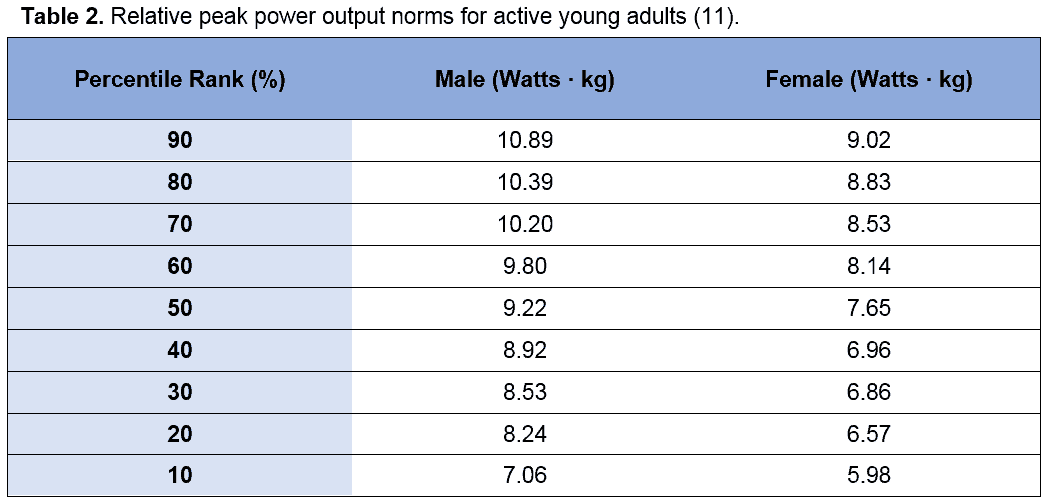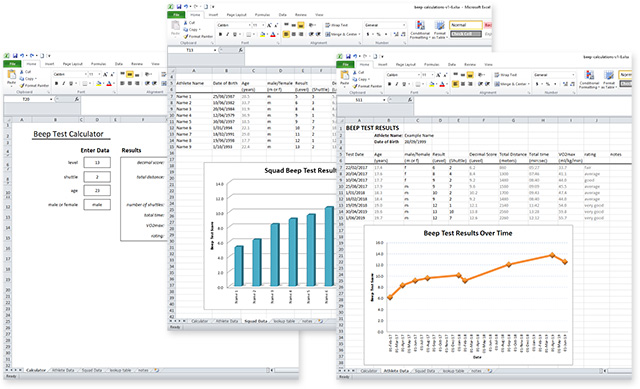

However, if the individual reaches the line before the second consecutive beep, their fail attempts are reset. If the athlete achieves two consecutive fail attempts, they are withdrawn from the test and their score recorded as final.
 If the athlete fails to reach the opposite ‘turn-around’ line before the ‘beep’, the participant is issued with one fail attempt. They must then run back and forth in this same pattern continuously until they reach voluntarily exhaustion. When instructed by the audio player, they must run towards the opposite 20m line (Cones B) within the sound of the beep. Participants begin the test from the ‘start-line’ (Cones A). A single beep indicates the end of each shuttle, whilst three simultaneous beeps indicates the start of the next level. As the individual progresses through the levels, the speed between the beeps decreases giving the individual less time to complete each shuttle, thus increasing the intensity. The starting speed is 8.5km/hr and increases by 0.5km/hr at each level thereafter. The test is comprised of 23 levels, each level lasts approximately 1-minute. Officiator recording the number of shuttles completed (explained in ‘Scoring’ section).įigure 1 displays the configuration for the Multistage Fitness test, this must be adhered to if accurate and reliable data is desired. CD or MP3 player with loud speaker (volume of speaker is particularly important). Multistage Fitness Test audio CD or MP3. Facility – Consistent, flat and non-slip (minimum length 25m). If the environment is not consistent, the reliability of repeated tests at later dates can be substantially hindered and result in worthless data. facility), so that it is protected from varying weather types, and with a dependable surface that is not effected by wet or slippery conditions. It is important to note that whenever fitness testing is performed, it must be done so in a consistent environment (i.e.
If the athlete fails to reach the opposite ‘turn-around’ line before the ‘beep’, the participant is issued with one fail attempt. They must then run back and forth in this same pattern continuously until they reach voluntarily exhaustion. When instructed by the audio player, they must run towards the opposite 20m line (Cones B) within the sound of the beep. Participants begin the test from the ‘start-line’ (Cones A). A single beep indicates the end of each shuttle, whilst three simultaneous beeps indicates the start of the next level. As the individual progresses through the levels, the speed between the beeps decreases giving the individual less time to complete each shuttle, thus increasing the intensity. The starting speed is 8.5km/hr and increases by 0.5km/hr at each level thereafter. The test is comprised of 23 levels, each level lasts approximately 1-minute. Officiator recording the number of shuttles completed (explained in ‘Scoring’ section).įigure 1 displays the configuration for the Multistage Fitness test, this must be adhered to if accurate and reliable data is desired. CD or MP3 player with loud speaker (volume of speaker is particularly important). Multistage Fitness Test audio CD or MP3. Facility – Consistent, flat and non-slip (minimum length 25m). If the environment is not consistent, the reliability of repeated tests at later dates can be substantially hindered and result in worthless data. facility), so that it is protected from varying weather types, and with a dependable surface that is not effected by wet or slippery conditions. It is important to note that whenever fitness testing is performed, it must be done so in a consistent environment (i.e. Beep test recording sheet how to#
How to conduct the Multistage Fitness test There are numerous variations of this test, but the most commonly used protocol has an initial running velocity of 8.5 km/hr, and increases the speed by 0.5 km/hr each minute thereafter.Īs this test is a measure of aerobic power, it is therefore typically used in sports which have a high aerobic demand such as: It is this increase in speed which reflects the increase in difficulty/intensity.

The time between recorded beep decreases each minute, forcing the individuals to increase their running speed. It requires the athlete to perform continuous 20m shuttle runs, whereby the individual must reach the opposite end of the 20m grid before the next beep sounds. It is an extremely simple test, which requires minimal equipment and demands the athlete(s) to run continuously until volitional exhaustion. This test was originally developed for adults in 1982 by Leger and Lambert (2) and then modified later in 1988 for children, by reducing the stages from 2-minutes to 1-minute by Leger et al (3). The multistage fitness test, otherwise known as the beep test, bleep test, or the 20m shuttle run test is a continuous sub-maximal test which has become the most recognised tool for measuring aerobic power (1). What is the Multistage Fitness (Beep) test?







 0 kommentar(er)
0 kommentar(er)
